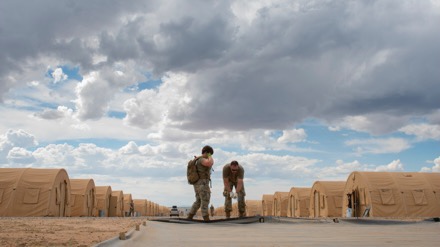
JOINT BASE LANGLEY – EUSTIS, Va. (AFNS) —
Air Combat Command has made significant progress on a number of Agile Combat Employment initiatives, including the creation of an agile battle lab.
As the command continues to anticipate changes and adapt to ACE concepts, innovation and integration has never been more important to members of the staff here.
Lt. Col. Adam Chitwood, ACC’s Agile Battle Lab commander, launched his unit into the ideology of accelerating change and influencing the necessity of ACE Airmen. The ABL mission is to accelerate technology, tactics and unit design to further ACE in ACC and around the Air Force.
More than 22 years ago, under Air Education and Training Command, ABL, then called Squadron Next, began with tests and experiments. Now, after transitioning to ACC in 2020, the ABL collaborates with many organizations, including ACC’s A6 communications directorate (cyber) units outside of ACC to find and solve problems, giving organizations effective ways to operate and train Airmen.

An Airman assigned to the 52nd Combat Communications Squadron from Robins Air Force Base, Ga. sets up a satellite in a simulated austere environment in Sunglow City during Exercise Bushwhacker 21-07 at Davis-Monthan Air Force Base, Ariz., Oct. 4, 2021. Bushwhacker allowed DM to execute and test Agile Combat Employment processes and timelines to pack up, load and re-establish wing facilities and command and control structures at newly established locations. Air Combat Command has made significant progress on several Agile Combat Employment initiatives, including the creation of an agile battle lab. (U.S. Air Force photo by Staff Sgt. Kristine Legate)
“One unit cannot solve all of the problems of the Air Force,” Chitwood said. “That’s why collaborating and adapting is so vital.”
The difference between the ABL and traditional ACC units is its unique mission. ABL’s ultimate goal is to reshape the way Airmen think, work and incorporate processes that elevate the capabilities of the Air Force in preparation for the future fight.
We are not focused on everyday problems. We’re focused on strategic and more operational level issues,” said Master Sgt. Andrea Murray, ABL’s intelligence integration manager. “We’re making changes in 18 to 20 months. Unlike traditional labs and units, we can’t wait 10 years. We need things to change now, and that’s what we’re doing.”
A major part of ACE is the creation of a multi-capable Airmen mindset. MCA is an initiative where a small group of Airmen will be trained to accomplish tasks outside their core Air Force specialty. They will train in a cross-functional team to provide combat support to aviation force elements conducting dispersed and dynamic operations. MCA will recover, refuel, reload, launch and defend mission generation force elements.
As MCA concepts expand across the Air Force, the need for immediate, effective change and improvements grows. According to Chitwood, with ACE being ABL’s primary effort, integrating MCA will become essential to the Air Force as a whole. ABL’s goal is to equip the force with more than capable Airmen.
“We, as Airmen, have to practice like we fight,” said Senior Master Sgt. Reid Beveridge, ABL superintendent. “War is not an additional duty. We need to practice MCA jobs and we need to identify failure gaps before we are called on to use [tactics, techniques and procedures] in combat.”
In December 2021, ABL led an ACE command control and communications operations rehearsal for ACC and joint partners. The success of the rehearsal resulted in a way ahead to plan and identify what future challenges adversaries might present Airmen.
“Developing and testing ACE concepts through the lab and other venues will ultimately give our Airmen decisional advantage in tomorrow’s fight,” Chitwood said.
By SSgt Jaylen Molden
Air Combat Command Public Affairs

